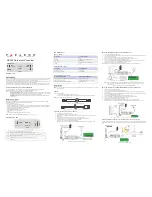
Technical data sheet 1.15-10.002-01-en
Multi radio connection MFA
D e v i ce De s c ri p ti on
Assembly
General installation notes
Devices communicating via radio can not always be assembled at arbitrary locations, as wireless data
transmission is more or less strongly influenced by the constructional and spatial conditions.
Prior to installation and assembly, therefore, the building structures must be analyzed and a series of
measurements must be carried out to determine the specific ranges inside the building. A corresponding Kieback
& Peter service and diagnosis tool is provided for this purpose.
To establish an operational and functionally secure communication path, the following aspects must be taken into
account prior to and during planning:
•
Natural and constructional influences limit the transmission ranges that can be realized. Building materials and
screening elements (e.g., installation shafts, fire doors, switching cabinet doors, etc.) must already be taken
into account during the planning phase.
High humidity increases the natural signal attenuation.
Warning
Recommendation: Plan the radio paths
horizontally, on one level
with max. 30 m distance
between transmitting and receiving components.
Note
•
Observe the minimum distances to potential sources of interference
- min. 0.5 m to high-frequency interference sources (e.g., microwaves, transformers, computers...)
- min. 3 m to transmitters of other function systems (e.g., wireless telephones, headphones...)
- min 0.1 m to metal and door frames
•
Minimize effective wall thicknesses, i.e. make wall passage of radio signals as vertical as possible.
FCS
FCS
correct
false
MFA
MFA
30cm
>30cm
230 V
230 V
•
Do not choose the installation site in the radio shadow of screening building parts/volumes
Î
no direct
reception possible.
•
In the fringe range of reliability, slightly change the position of transmitter/receiver if required
(to reduce heterodyne radio waves).
Page 4 / 8


























